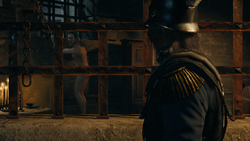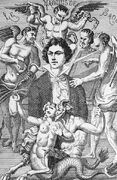
|
Patience, brothers. Soon we will reveal the secrets of Assassin's Creed: Unity. This article has been identified as being out of date. Please update the article to reflect recent releases and then remove this template once done. |
- "Conspiracy! Intrigue! A rapidly thickening plot! Add some bestiality and a lecherous priest and I'd say you have the beginnings of a beautiful novel."
- ―The Marquis de Sade, 1791.[src]
Donatien Alphonse François, Marquis de Sade (2 June 1740 – 2 December 1814), commonly known as the Marquis de Sade, was a French aristocrat, revolutionary politician, philosopher and author famous for his libertine sexuality.
Biography
Early life
Born in 1740, de Sade came from a typical French noble family, with relatives among the army and the clergy.[1] His father was a libertine and diplomat, while his mother was a lady-in-waiting to the Princess of Condé and rarely saw him. He grew up cultured and spoiled, having every wish fulfilled, while his own inclinations became visible. By the age of four, de Sade had become an arrogant and spoiled bully, beating the young Prince of Condé. For this, de Sade was sent to live with his uncle, the Abbé de Sade. The Abbé, however, was debauched and reminiscent of the clergymen appearing in de Sade's later works, introducing his six-year-old nephew to his own sexual interests,[2] as well as pornographic litterature.[3]
De Sade developed a sexual cruelty and grew fascinated with violence and prostitutes, in addition to defying all authority, rule or standard.[2] Somewhat a black sheep, he was an atheist and fond of the performing arts. Due to his family's influence and wealth, he was able to get away with many crimes[1] and sate practically any desire that crossed his mind.[2]
At the age of fifteen, de Sade joined the cavalry of the French Army and began a brief, but distinguished career. He fought in the Seven Years' War and rose through the ranks to become a colonel, gaining attention for his bravery and womanizing. At that time, his deviant sexual preferences were not known to the public.[4] At the age of thirty-one, de Sade left the army[1] and spent his time living at the Château de Lacoste, beginning a life of libertinism.[3]
Scandals
In 1763, with the King's blessing,[3] de Sade married the uninteresting, but extremely wealthy noblewoman Rénée-Pélagie de Montreuil[4] at the Church of Saint-Roch in Paris.[3] Together, they had two sons and one daughter. At the same time, he had an affair with his sister-in-law, Anne-Prospère, and frequently indulged in local prostitutes.[4] By de Sade's twenties, brothels were warned not to let him take prostitutes off the property, and on one occasion, he forced a prostitute to listen to his arguments in favor of atheism for an entire night. The following day, she had him arrested.[2]
In 1768, de Sade became the center of a scandal and was marginalized by society when he hired a woman as a chambermaid, only to tie her up, cutting wounds in her, into which he poured hot wax.[2] As a result, his enraged mother-in-law had him imprisoned. He soon returned to his old ways, however, partying with ill-reputed women and at one point using the aphrodisiac Spanish fly on a group of prostitutes, leading to an accusation of poisoning and a death sentence. Fleeing to Italy, his effigy was executed in his absence.[4]
De Sade's infamy only spread when, in 1776, he hired a group of girls as well as one boy and subjected them to weeks of experimental orgies and deviance. In 1777, the father of one girl later tried to shoot him, but the gun misfired.[4] Later that year, de Sade was tricked into going to Paris to visit his mother, who he believed was ill, unaware of her death. He was imprisoned at the Château de Vincennes, where he met the Comte de Mirabeau; the two came to share a mutual hatred of one another.[2] Throughout his years in prison, de Sade wrote several works, almost all of which were regarded as obscene and were heavily censored.[1] The 120 Days of Sodom was inspired by his orgies,[3] while Justine was described by himself as being capable of "corrupting the devil".[4] Although he successfully appealed his own death sentence in 1778, he remained imprisoned and was transferred to the Bastille when Vincennes closed in 1784.[2] His incarceration there was luxurious, and he brought with him tapestries, perfumes, a full wardrobe, paintings and over a hundred a books.[2]

De Sade in the Bastille
When taking walks during his time there, he disturbed the public, and was forbidden from this activity. He then began shouting from his cell window that the prisoners were being killed by the guards,[2] at one occassion being nude while doing so. When Arno Dorian was imprisoned at the Bastille in May 1789, de Sade took note of the young man, keeping his eye on him the following two years.[1] On 4 July, de Sade was transferred to the Charenton asylum, missing the storming of the Bastille by ten days. At the time, he had been working on his manuscript of The 120 Days of Sodom, and believed it was lost during the transfer.[2]
Personality and characteristics
De Sade was a proponent of extreme freedom, unrestrained by morality, religion or law. He was a noticeably flamboyant, eccentric and hedonistic man. As a libertine, de Sade had no moral qualms, and hence embraced a criminal lifestyle. His time in prison did nothing to reform him, and he even made a mockery of it by feigning insanity.
De Sade was also a passionate and gifted writer, philosopher, and spoke very eloquently and metaphorically. Despite his charm and charisma, his personality could be seen as lecherous and obnoxious, particularly to Arno Dorian and Élise de la Serre.
Trivia
- Alexandre Amancio noted Unity's depiction of the Marquis de Sade has been based on Hannibal Lecter.[5]
Gallery
References
- ↑ 1.0 1.1 1.2 1.3 1.4 Assassin's Creed: Unity
- ↑ 2.0 2.1 2.2 2.3 2.4 2.5 2.6 2.7 2.8 2.9 Assassin's Creed Unity: Abstergo Entertainment - Employee Handbook
- ↑ 3.0 3.1 3.2 3.3 3.4 Project Widow
- ↑ 4.0 4.1 4.2 4.3 4.4 4.5 The Marquis de Sade - Mad, bad and dangerous to know
- ↑ GameInformer: Special Edition Podcast – Assassin's Creed Unity



